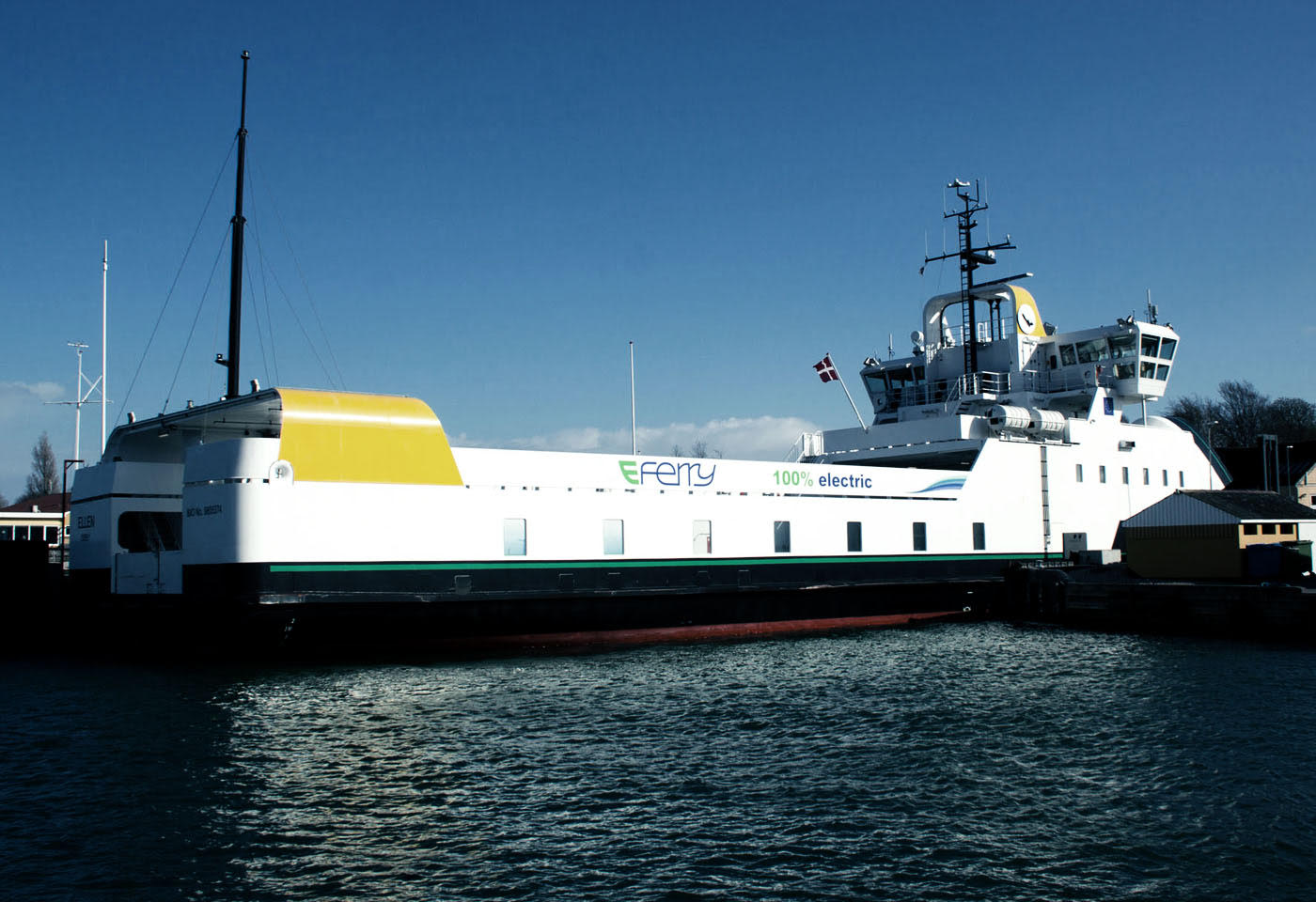Hybrid Ferry Kanalen

100 % electric battery ferry Ellen for Søby-Fynshav route operated by Aeroe-Ferries also known as the E-ferry project supported by EU Horizon 2020.
The goal of the E-ferry project was to build a full-scale prototype to demonstrate 100 % emission-free sailing on a regional ferry route with an unprecedented range for a fully-electric ferry. As the project officially came to its end on June 1, the overall goal has been achieved to full satisfaction. Ellen has now shed her ‘experimental’ and ‘prototype’ status and has simply become a great performer for the ferry operator. Here are some key numbers which are explained in more detail below:
– Energy efficiency: 85 % grid-to-propeller – Energy consumption, 22 nautical mile (approx. 40 kilometer) roundtrip: 1600 kWh – Years before higher investment cost of new e-ferry turns into savings by low operational costs: 4-8 – CO2 emissions saved in comparison to a modern diesel: 2.520 tonnes/year – Passenger satisfaction: Very high
Energy efficiency and consumption The energy efficiency of the total electrical system is 85 % grid-to-propeller. This is more than twice as high as the efficiency of a typical diesel ferry (tank-to-propeller). At an average consumption of 1600 kWh per return trip, the E-ferry performs slightly better than had been projected in preliminary studies. The low average energy consumption per trip, in combination with an available battery capacity of more than 3.8 MWh and a fast charger (4 MW peak charge), has proven that the E-ferry prototype is a valid commercial alternative to traditional diesel- and diesel-electric propelled ferries.
Fully electric ferries are more economical than traditional diesel ferries Remarkably, calculations show that the higher investment costs for building fully electric are in fact already compensated for after just 5-8 years of operation, even when taking into account the cost of the charging station and the potential necessity for replacing the battery pack twice over the vessel’s total lifetime. This means that the higher investment costs are paid for early – and for the remainder of the ferry’s 30-year lifetime, the operator will save between 24% and 36% in operating cost, compared to operating a diesel or diesel-electric ferry. The analysis also concludes that a change in ownership structure to the charging station could bring cost parity further forward to only 4 years.
E-technology is constantly becoming cheaper The battery systems have been a major contributor to the E-ferry prototype’s initial investment costs, but the decrease in cost has more than halved the price in the project period.This makes the perspective for fully electric vessels even better in the future. Another main contributor to the total cost of the E-ferry prototype has been the electrical infrastructure and charging system – in the case of the Ellen, the operator had to include the expense of all the systems. However, in the future charging systems can be expected to be installed in many ports as part of the common infrastructure. At the same time standardization efforts are being exercised already and economies of scale start to apply.
Environmental benefits It is estimated that the E-ferry saves the environment 2.520 tons of CO2, 14,3 tons of NOx, 1,5 tons of SO2, 1,8 tons of CO and half a ton of particulate matter annually, compared to a similar modern diesel ferry. Compared to an older, existing ferry of similar type and performance, the Ellen saves close to 4000 tons of CO2, 70,8 tons of NOx, 2,4 tons of SO2, 3,1 tons of CO and 1,4 tons of particulate matter. Naturally, such reductions depend on the E-ferry using ‘green’ electricity, i.e. electricity produced by clean renewable sources such a wind and sun. The E-ferry Ellen is charged from the local grid on the island of Ærø where wind turbine production accounts for 125% of the islands electricity demand on an annual basis. However
the municipality buys certificates of origin for green electricity equal to the energy volume used via the local electricity supplier. This extra cost is accounted for in the economic evaluation.
If by contrast the Ellen was using electricity from the standard Danish grid mix, savings would still be significant, 2.010 tons of CO2 compared to the other alternatives. As evidenced by the evaluation of the E-ferry, it is also important to realize that the efficiency of electric propulsion is so much higher than the efficiency of a diesel, that even when charged with electricity from other more fossil fuel based European grids, the electric propulsion system would still result in a reduction in emissions.
Environmental life-cycle analysis In terms of environmental impact, life-cycle analysis shows that also when taking into consideration the resources and raw materials needed for producing batteries, the E-ferry prototype overall fares much better than its alternatives. The CO2 emissions estimated to be a result of the battery production (215-430 tons) equals about 3 months worth of emissions from the best diesel-electric peer. Used batteries that no longer hold enough power to be dispatched for ferry operations (below 80% of nominal capacity), are still useable for other purposes, for instance as part of battery storage on shore for balancing electric grids. Many projects, globally, are looking to take advantage of used batteries. However, large-scale common procedures for recycling completely spent batteries are not yet in place.
Passengers love the Ellen Passengers have welcomed the emission-free ferry and its sailing characteristics with enthusiasm. The environmental benefits are highly rated by the E-ferry’s passengers, who overall report that they are either ‘extremely satisfied’ or ‘very satisfied’ with the E-ferry in operation. Along with a high appreciation for the environmental friendliness of the E-ferry, passengers also highly rate the much less noisy and completely smog-free operation. Likewise, passengers rate safety, comfort and travel time (reduced by more than 20 % compared to the diesel it replaced) as either ‘extremely satisfying’ or ‘very satisfying’.
YEAR: 2020
WHAT: Electric ferry
WHERE: Ærø, Denmark
